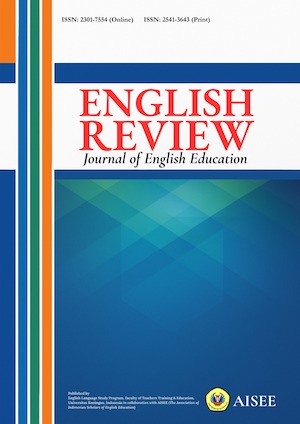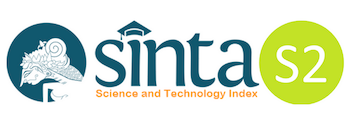ENHANCING EFL SPEAKING SKILLS THROUGH SPOTIFY: THE POWER OF INTERACTIVE COMMENTS
Abstract
The ability to communicate verbally is essential for learners to interact within society, particularly in mastering English speaking skills. However, many students struggle with speaking due to a lack of understanding, confidence, and fear of criticism. This study aims to motivate students to enhance their speaking skills through the use of the Spotify application for commenting. Utilizing a qualitative descriptive approach, data were collected through observations, interviews, and document analysis involving 20 students. The findings indicate that the use of Spotify significantly motivated students and improved their speaking abilities. This is evidenced by the variety and quality of comments submitted by the students. The results suggest that integrating digital media like Spotify in language learning can effectively enhance students' speaking skills by providing a flexible and engaging platform for practice.
References
Al Hosni, S. (2014). Speaking Difficulties Encountered by Young EFL Learners. International Journal on Studies in English Language and Literature (IJSELL), 2(6): pp. 22-30.
Apoko, T. W., Dunggio, A. A., & Chong, S. L. (2023). The students’ perceptions on the use of mobile-assisted language learning through Duolingo in improving vocabulary mastery at the tertiary level. English Review: tuanJournal of English Education, 11(1), pp. 17-26. https://doi.org/10.25134/erjee.v11i1.7069
Arsyawan, R. A., Shodiq. J., & Wulandri, S. (2023). Students’ Perceptions on Spotify Application in Improving English Pronunciation. Didaktik : Jurnal Ilmiah PGSD FKIP Universitas Mandiri, 09 (04), 2477-5673.
Bailey, K. M. (2005). Speaking in Practical English Language Teaching. Singapore: MrGrawwHill.
Elisa, L. (2023). Students’ Perceptions of Using Digital Media in English Language Learning. Journal of Social Work and Science Education, 4(3), pp. 937-949.
Fadhli Rahmat, Suharyadi, A., Firdaus, F. M., Bustari, M. (2023). Developing a digital learning environment team-based project to support online learning in Indonesia. International Journal of Evaluation and Research in Education (IJERE), 12(3), 1599-1608. DOI: 10.11591/ijere.v12i3.24040
Fatimah, A. S., Santiana, S., & Saputra, Y. (2019). Digital comic: An innovation of using ToonDoo as media technology for teaching English short story. English Review: Journal of English Education, 7(2), 101-108. https://doi:10.25134/erjee.v7i2.1526
Haristiani, N., Mumu, M.R. (2020). Combining Chatbot and Social Media: Enhancing Personal Learning Environment (PLE) in Language Learning. Journal of Science & Technology, 5(2), pp. 487-506.
Hasanah, M., &Wahono, S. S. (2022). Watching English Native Speakers’ Youtube Channel to Improve Students’ Pronunciation Ability. Journal of Language Intelligence and Culture. 4(1), pp. 15-32.
Ilyas, A. A., & Kaniadewi, N. (2023). Students’ Perception on the Use of Spotify to Improve Students’ Pronunciation. English Education Journal. 3(2), pp. 119-132.
Kamal, F. B., Rita, F. and Wahyudin (2014). Developing speaking skill of the tenth grade students through acoustic song. English Language Teaching Society (ELTS), 2(1): 1-11.
Kusmaryono, I., & Basir, M. A. (2024). Learning Media Projects with Youtube videos: a Dynamic tool for Improving Mathematics Achievement. International Journal of Evaluation and Research in Education , 13(2), 934-942. https://doi.org/10.11591/ijere.v13i2.26720
Maesyaroh, S., Asikin, N. D., & Daswa. (2023). Advancing English language learning: Innovations in web-based learning media qmedia of english learning during covid-19 pandemic. English Review: Journal of English Education,10(2), 475-484. https://doi.org/10.25134/erjee.v10i2.6248
Parmawati, A. and Inayah, R. (2019). Improving students’ speaking skill through English movie in scope of speaking for general communication. ELTIN Journal. 7(2): 43-53. https://doi.org/10.22460/eltin.v7i2.p43-53
Permana, A. I., Megawati, F. (2021). Disney Movie Soundtrack: Does It Give Effect to Students’ Speaking Skill?. Script Journal: Journal of Linguistics and English Teaching, 6(2): pp. 143-153. http://jurnal.fkip-uwgm.ac.id/index.php/Script
Pinem, Y. A., & Rahmawan, A. D. (2023). Elements of Digital Media in Vocabulary Remote-Learning Achievement. International Journal of Evaluation and Research in Education (IJERE). 12(2), pp. 893-904.
Prasojo, D. L., & Yuliana, L. (2021). How is social media used by indonesian school principals for instructional leadership?. Cakrawala Pendidikan. 40(1), pp. 70-80.
Sagita, M., Ramlan, Vita N. (2020). The Effect of Using English Songs on the Students’ Speaking Skill. Jurnal Sains Riset (JSR). 10(1) , pp. 88-93
Saleh, Y. R., Akhmad, E., & Akhmad, Z. (2023). Non-linguistic aspect caused students’ foreign language anxiety in speaking English. English Review: Journal of English Education, 11(3): 917-924. https://doi.org/10.25134/erjee.v11i3.7803
Setyaningsih, S.I. S., Fansury, A. H., Maulina. (2022). Verbal-linguistics Intelligence Towards Student’s Speaking English Skills Using Digital Media (Audio Visual) in the Classroom.sg Journal of Education, Language Teaching and Science. 4(2), pp. 296-306.
Traxler, J. (2016). Mobile learning and learning analytics: Capturing the evidence, integrating experience, informing practice. In Mobile Learning Analytics (pp. 1-17). Springer International Publishing.
Wahidah F. S. (2016). Students’ Speaking Problems and Factors Causing it. JURNAL LOGIKA. 16(1), pp. 1-10.
Wahono, S. S., & Zahro, I. H. N. (2021). Using Inquiry Based Learning to Improve Student’s Speaking Skills. Journal of Language Intelligence and Culture. 3(2), pp. 125-138.
Wicaksana, H. S., Kusumaningrum, R., Gernowo, R. (2024). Determining community happiness index with transformers and attention-based deep learning. IAES International Journal of Artificial Intelligence (IJ-AI). 13(2), pp. 1753-1761.
All articles published in English Review: Journal of English Education (ERJEE) are licensed under the Creative Commons Attribution 4.0 International License (CC BY 4.0).
Copyright Ownership
Authors retain the copyright of their articles and grant ERJEE the right of first publication. The journal is granted a non-exclusive license to publish, reproduce, and distribute the article in any format, medium, or platform, provided that proper credit is given to the original authors.
License Terms – CC BY 4.0
Under the Creative Commons Attribution 4.0 International License, others are free to:
- Share — copy and redistribute the material in any medium or format
- Adapt — remix, transform, and build upon the material for any purpose, even commercially
As long as they:
- Provide appropriate credit to the original author(s) and source
- Provide a link to the license (https://creativecommons.org/licenses/by/4.0/)
- Indicate if any changes were made
There are no restrictions on the reuse, reproduction, or adaptation of published articles as long as attribution is properly given.
Author Warranties
By submitting a manuscript to ERJEE, authors confirm that:
- The work is original and does not infringe any existing copyright.
- The manuscript has not been previously published and is not under consideration elsewhere.
- All sources and references are appropriately acknowledged.
- Necessary permissions have been obtained for any copyrighted materials used.









